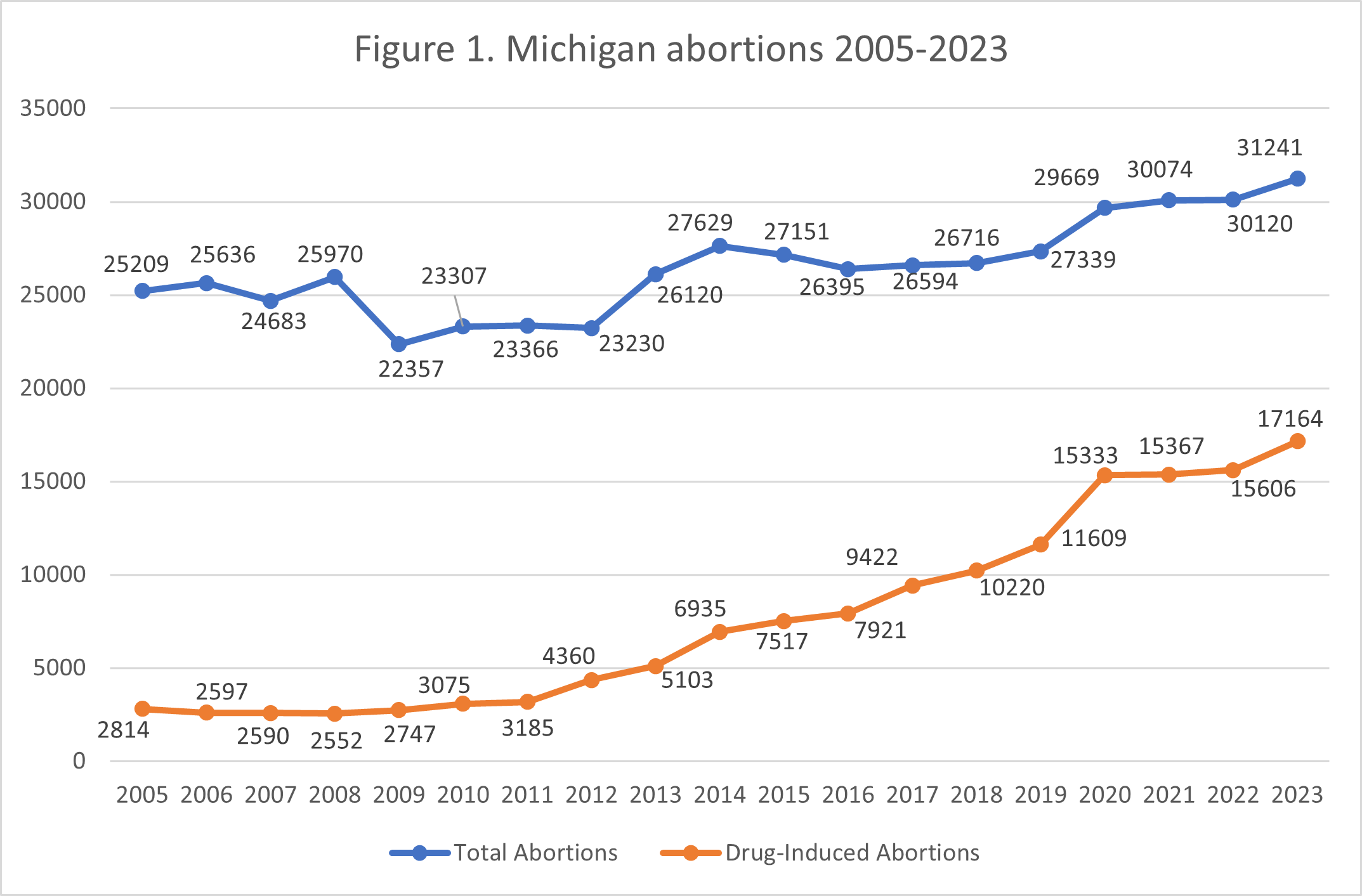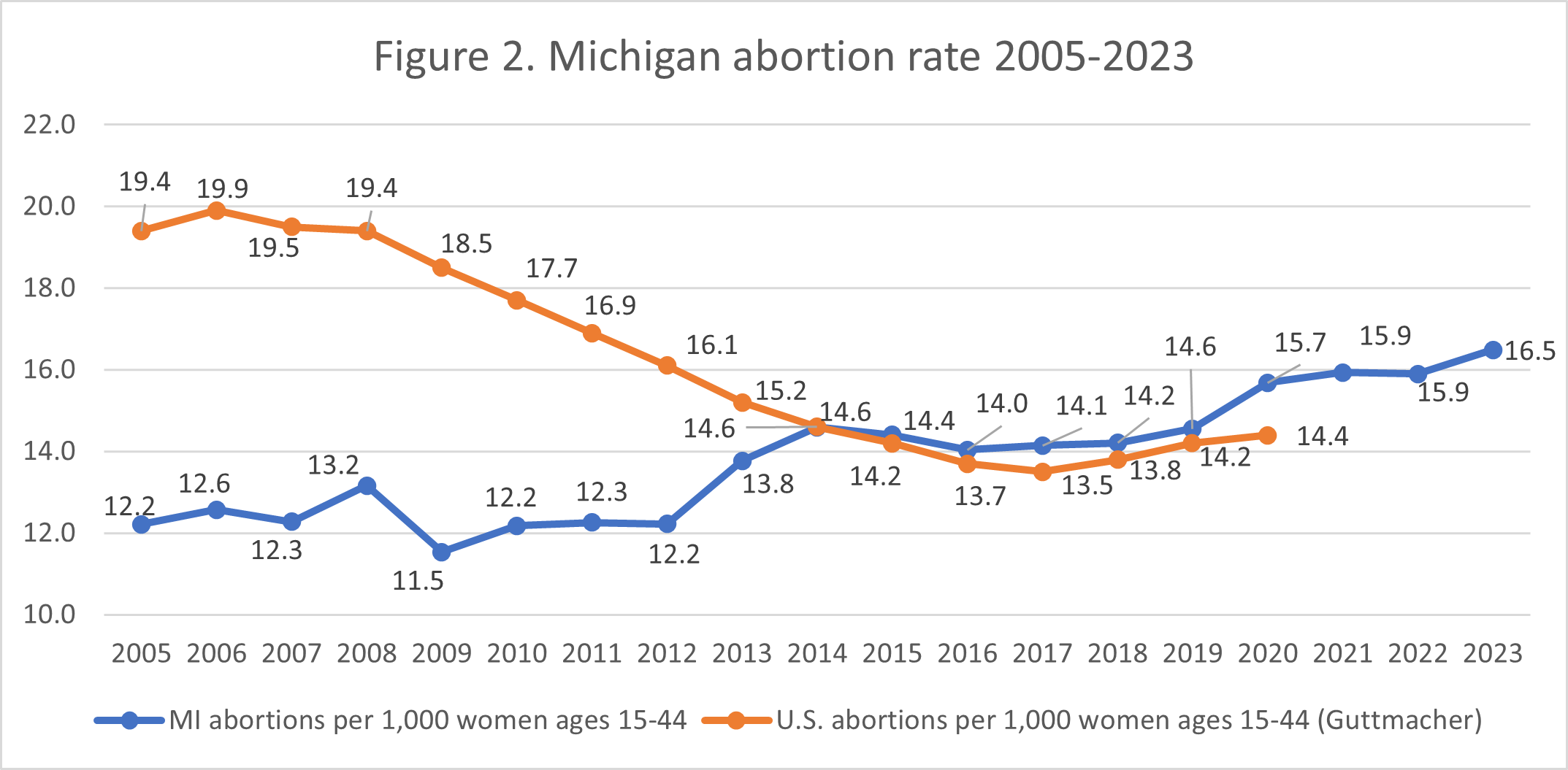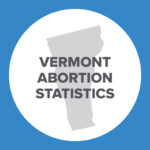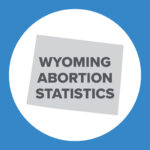Abortion Reporting: Michigan (2023)
Michigan’s Department of Health and Human Services published its 2023 abortion statistics in July 2024, showing that abortions had increased from the previous year. The Department of Health announced that it will no longer report Michigan’s abortion data for abortions that were performed in 2024 and beyond as a result of legislation passed in the fall of 2023.
Statistics and Changes in Michigan Abortions, 2022-2023

The report does not include information on Planned Parenthood’s Michigan abortion market share.
Abortion Totals and Trends
In 2023, there were 31,241 abortions reported in Michigan, up 4% from the previous year and the highest reported total since 1995. Drug-induced abortions increased by 10%, constituting 55% of the total in 2023 (Fig. 1). The Charlotte Lozier Institute (CLI) estimates that Michigan’s 2023 abortion rate (16.5 abortions per 1,000 women ages 15 to 44) increased by 4% from its 2022 rate of 15.9 (Fig. 2).2 As of November2024, 21 states have released 2023 statistics, nine of which showed that abortions increased from 2023.
State Report Summary
Resident Abortions
In 2023, 91% of Michigan abortions were performed on residents, and much of the information in Michigan’s report is only for resident abortions, with abortions on nonresident women excluded. Eight percent of the abortions performed on Michigan residents were on girls younger than 20, and 26% were on women ages 20 to 24. Twenty-nine percent were on women ages 25 to 29, while 23% were on women ages 30 to 34 and 10% on women ages 35 to 39. Three percent of the abortions were on Michigan residents ages 40 and older. Under one percent of abortions were on women whose age was not reported.
Over half of Michigan resident abortions were performed on black women (53%), while 35% were obtained by white women. Two percent were performed on Asian or Pacific Islander women, 0.6% on American Indian women, 3% on women of other races, and 2% on women of multiple races. Four percent of the abortions were on women whose race was not reported. The black abortion rate (50.5 abortions per 1,000 women ages 15 to 44) was over seven times the white abortion rate of 7.0. Michigan reports ethnicity separately from race, and 5% of resident abortions were performed on Hispanic women.
Ten percent of resident abortions were on married women, 87% on unmarried women, and 3% on women of unknown marital status. Forty-eight percent of abortions were on women who had reported no previous abortions, just under a quarter (24%) were on women with one prior abortion, and over a quarter (28%) were on women with more than one. Just under a quarter of the abortions (23%) were performed on women who previously had a miscarriage. Thirty-five percent of Michigan resident abortions were performed on women with no previous term pregnancies, which Michigan defines as a pregnancy “which lasted 37 weeks or longer, regardless of the outcome.” Twenty-six percent of abortions were obtained by women with one prior term pregnancy, and 39% were on women with more than one.
Michigan records the entity that referred each woman to the abortion facility, and in 2023, a majority of the abortions (89%) were self-referrals. Nine percent of the women undergoing abortions were referred by friends or family members, and only 1% were referred by a physician. Twenty-nine women were referred by a family planning agency, four women by the state’s health department, two by a social agency, and two by clergy. There were 17 women who received some other referral, and the source of referral was not reported for 38 abortions. The vast majority of the abortions on Michigan residents, 98%, were self-paid, while 2% were covered by insurance.
Total Abortions
Ninety-one percent of Michigan’s abortions were performed on resident women while 9% were performed on nonresident women. Women from Ohio (5% of the total abortions in the state), Indiana (2%), and Texas (138 abortions) composed the largest number of nonresident women who obtained abortions in Michigan in 2023.
Sixty-nine percent of all abortions reported in Michigan occurred at eight weeks of gestation or earlier, with 1% performed before five weeks of gestation and 68% performed between five and eight weeks. Twenty percent were performed between nine and 12 weeks. Seven percent of the abortions occurred from 13 to 16 weeks of gestation and 3% were performed between 17 and 20 weeks. There were 478 abortions, 2% of the total, performed at 21 weeks and later. Of these, 476 were performed between 21 and 24 weeks, one between 25 and 28 weeks, and one abortion reported after 28 weeks. There was an 18% increase in the number of abortions that occurred at 21 weeks or later from 2022 (406) to 2023 (478). Gestational age was not reported for 43 abortions.
A majority of the abortions reported in Michigan, 55%, were drug-induced. Thirty-eight percent were suction curettage procedures, and 6% were dilation and evacuation (dismemberment) abortions. There were five dilation and curettage abortions and two hysterectomy/hysterotomies. Twenty-three abortions were performed using other, unspecified methods, and the type of procedure was not reported for 18 abortions.
In 85% of cases, pregnancy was confirmed via ultrasound. For 14%, pregnancy was confirmed with a home urine test, and for 0.2%, pregnancy was determined with a lab urine test. There were 34 pregnancies confirmed using a lab blood test, two in which another method was used, and seven that were not tested. There were 34 abortions for which an unknown method was used to confirm pregnancy.
Eighty-one percent of Michigan abortions were performed in freestanding abortion facilities. Only 0.1% were performed in doctor’s offices, 0.9% in hospitals, and 17% were performed in some other type of facility. Six percent of the unborn babies killed by abortion weighed one to 99 grams, and 2% weighed between 100 and 399 grams. There were 217 babies who weighed 400 grams or more (0.7%). However, weight was not determinable for 91% of the unborn babies.
Abortions by Resident County
Of note are the five counties with the highest Michigan-resident abortion rates and totals. Wayne County (which includes Detroit City) had an abortion rate of 31.2, with 10,822 total abortions performed on county residents. Detroit itself had an abortion rate of 50.6 (almost four times the national rate as estimated by the Guttmacher Institute in 2020), and the rest of Wayne County, excluding Detroit, had an abortion rate of 19.4. Detroit’s abortion total constituted 23% of the state’s total resident abortions. Other counties with high abortion rates and totals include Oakland County (14.5, 3,415 abortions), Macomb County (19.3, 3,166 abortions), Genessee County (21.1, 1,581 abortions), and Kent County (10.6, 1,477 abortions).
Abortion Complications
There were 16 immediate complications reported during 2023 Michigan abortion procedures, a four-fold increase from 2022. There was one instance of shock, two of cervical lacerations, 11 cases of hemorrhage, and one instance each of infection and other, unspecified complications.2 Four complications occurred between five and eight weeks of gestation, two between nine and 12 weeks, three between 17 and 20 weeks, and seven between 21 and 24 weeks. Six of the 16 complications occurred during suction curettage procedures, seven during dilation and evacuation procedures, two during drug-induced abortions, and one during a hysterectomy/hysterotomy procedure. Ten of the 16 immediate complications occurred during an abortion performed at a hospital and six during an abortion at a freestanding outpatient surgical facility.
Additionally, 247 abortions resulted in complications that were reported subsequent to the abortion procedure, an increase of 39% from 2022. Multiple complications can be reported for each abortion. There were 122 failed abortions (“failed abortion” usually indicates that the abortion did not work, and the pregnancy is ongoing). There were 83 cases of retained products, 10 of infection, nine of hemorrhage, three of cervical laceration, and 24 other unspecified complications. Five subsequent complications occurred after abortions at five weeks of gestation or less, 161 after abortions at five to eight weeks of gestation, 51 after abortions at nine to 12 weeks of gestation, 14 after abortions at 13 to 16 weeks of gestation, three after abortions at 17 to 20 weeks of gestation, and three after abortions at 21 weeks of gestation or later. Fifty-three of the subsequent complications were associated with suction curettage abortions, 178 with drug-induced abortions, 14 with dilation and evacuation abortions, and two with other, unspecified methods.
State Ranking
In CLI’s 2024 paper reevaluating abortion reporting across the United States, Michigan’s reporting tied for last. This is because, as mentioned in the initial section of this analysis, legislation passed in the fall of 2023 stripped the state’s abortion reporting requirement from the state’s statute code. In 2016 when CLI originally analyzed states’ abortion reporting requirements, Michigan’s reporting was among the best, ranking in seventh place. To return to that ranking and even improve upon it, the state should reenact its abortion reporting requirement and provide information for all abortions occurring in the state, not just those performed on residents.


- National rates were calculated by the Guttmacher Institute. Michigan rates were calculated by CLI using the following formula: (total number of abortions performed in Michigan ÷ number of resident women ages 15-44 [based on most recent population estimates]) x 1,000. Rates may differ slightly from previous CLI articles due to revised population estimates. Population estimates were obtained from the CDC WONDER database. Estimates for 2005-2009 are intercensal estimates of the July 1 resident population. Estimates for 2010-2019 are Vintage 2020 postcensal estimates of the July 1 resident population. Estimates for 2020-2022 are Vintage 2022 postcensal estimates of the July 1 resident population. Estimates were produced by the U.S. Census Bureau and the National Center for Health Statistics. Rates for 2023 were calculated using the Vintage 2022 postcensal estimates because 2023 population estimates have not yet been released by the CDC.
- Statistics on abortion complications reported here represent a minimal number of deaths and complications, as this data is collected in a non-systematic and non-verifiable way. As such, this data cannot be used to calculate either an accurate abortion mortality rate or an accurate abortion complication rate for the state.






















